It’s a common moment of confusion for any homeowner: you invested in a beautiful, durable fixture, only to ask yourself, “Why do I have rust spots on my stainless steel sink?” The very name “stainless” suggests it should be immune to such blemishes. The good news is that in almost all cases, it’s not the sink itself that is rusting. Understanding the science behind stainless steel and the common culprits of corrosion is the first step toward restoring your sink’s original shine and keeping it that way for years to come.

What Makes Stainless Steel 'Stainless'?
Before diving into the causes and solutions, it’s helpful to understand what stainless steel is. It's an iron-based alloy, but what gives it its remarkable properties is the addition of chromium—at least 10.5% by mass. When exposed to oxygen, the chromium forms a very thin, invisible, and durable passive layer of chromium oxide on the surface of the steel. This microscopic layer is what protects the iron within the alloy from moisture and oxygen, thereby preventing rust. However, this protective layer, while tough, is not invincible. When it gets scratched, damaged, or compromised by certain chemicals or deposits, the underlying iron can become exposed and react with water to form iron oxide, which we see as those frustrating orange or brown rust spots.
Common Causes for Rust Spots on a Kitchen Sink
The appearance of rust is almost always due to external factors rather than a fault in the sink itself. These orange-colored stains are typically caused by iron particles from outside sources that have settled on your sink's surface. These particles then rust, staining the sink. Identifying the source is key to preventing a recurrence.
One of the most frequent culprits is metal cookware or cleaning tools. Leaving wet cast iron pans, carbon steel knives, or metal food cans in the sink can lead to direct iron transfer and subsequent rusting. Similarly, using steel wool or other abrasive metal scouring pads to clean your sink is a major cause of trouble. These pads can not only scratch the protective chromium oxide layer but also leave behind tiny iron particles that will inevitably rust.
Another source can be your water supply, especially if you have well water or live in an area with older iron pipes. The water can carry fine particles of iron that, over time, deposit onto the sink surface and oxidize. Even seemingly harmless items like paper clips or bobby pins accidentally left in a wet sink can quickly create a noticeable rust stain. Lastly, certain chemicals, particularly those containing chlorides (like bleach), can be aggressive toward the passive layer on stainless steel. If these chemicals are not rinsed away promptly and thoroughly, they can break down the protective film and allow corrosion to begin.
A Step-by-Step Guide to Removing Rust Stains
Restoring your sink to its former glory is usually straightforward. The key is to use non-abrasive methods and always work in the direction of the steel's grain or finish lines to avoid creating micro-scratches. Start with the gentlest method first.
For light stains, a simple paste of baking soda and water is highly effective. Apply the paste to the rust spot and let it sit for about 30 minutes. Then, using a soft cloth or sponge, gently rub the area, moving with the grain of the steel. Rinse thoroughly with water and dry with a clean microfiber cloth.
If the baking soda paste isn’t quite enough, you can move on to a mild acid. White vinegar or lemon juice works well. Dampen a cloth with vinegar and lay it over the stain for about 20-30 minutes. Gently scrub, rinse, and dry. For more stubborn spots, a specialized non-abrasive cleaner designed for stainless steel, such as one containing oxalic acid, is an excellent choice. Always follow the manufacturer's instructions carefully, apply the cleaner to a soft sponge, work it into the stain along the grain, and rinse completely.
Long-Term Prevention: Keeping Your Sink Flawless
Once your sink is clean, preventative maintenance is the best strategy. The single most effective habit you can adopt is to rinse and dry your sink after each use. A quick wipe-down with a soft cloth prevents mineral and iron deposits from settling and removes the moisture needed for rust to form. Avoid leaving metal items, especially cast iron or tin cans, in the sink for extended periods. Instead of using steel wool, opt for soft sponges, nylon scrubbers, or microfiber cloths for all your cleaning needs. For an added layer of protection, consider using a silicone or rubber sink mat. This prevents metal pots and cutlery from making direct contact with the sink’s surface, significantly reducing the risk of scratches and iron particle transfer.
Starting with a high-quality foundation makes this maintenance even easier. For instance, our Stainless Steel Kitchen Ensemble features a deep-basin, corrosion-resistant stainless steel sink crafted from premium-grade steel. A higher quality material means a more robust and stable chromium oxide layer, offering superior resilience against the everyday challenges that can lead to staining. When you invest in a thoughtfully designed system, you're not just getting beautiful aesthetics; you're getting durable functionality that simplifies care and ensures lasting beauty in the heart of your home.








